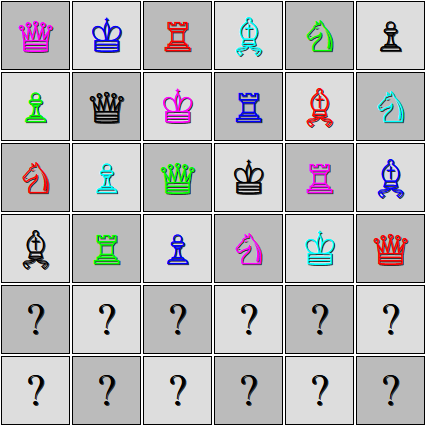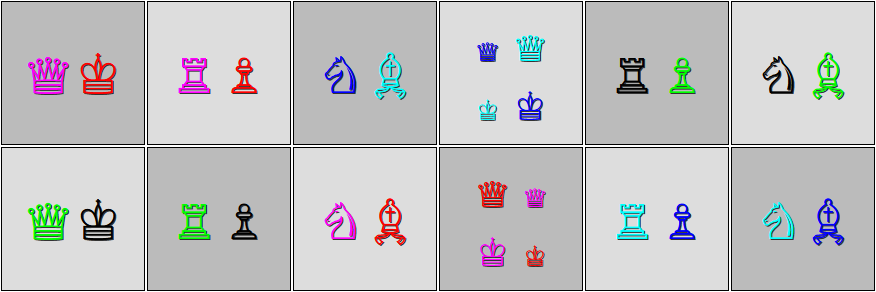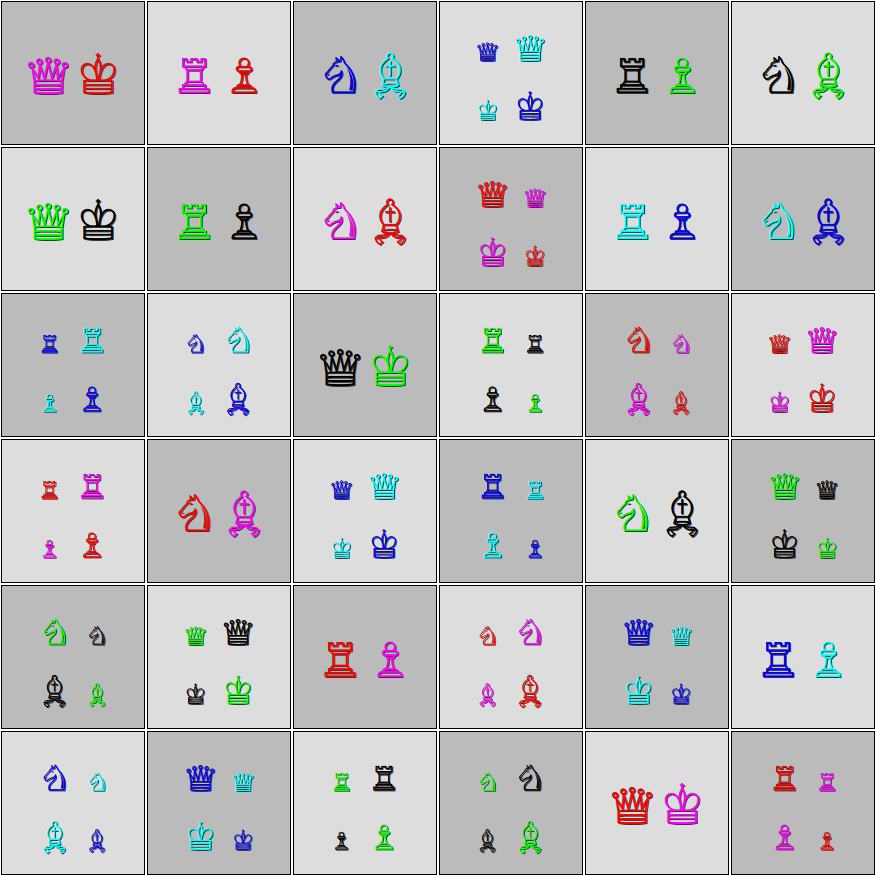Golden AME state of four subsystems with six levels each.
Classical 5-dimensional case
Consider five different elements in five different colors. For example, take five pieces of chess game each painted in red, blue, green, black and magenta. It is easy to arrange them into a 5 × 5 grid such that every row and every column contains exactly one piece with no color repetition along horizontal and vertical direction.
From mathematical point of view this exceptional pattern corresponds to two orthogonal Latin squares and one of many possible solutions in 5-dimensional space may be expressed as follows:

Classical 6-dimensional case
There are two cases where such solution does not exist: in two- and six-dimensional space — the latter one being the famous thirty-six officers problem once considered by Euler. One can try to fill the empty cells below to see that the constraints are too strong to allow a proper distribution of six pieces in any of the remaining rows.

Quantum 6-dimensional case
However, in quantum realm one can circumvent the classical rules by making use the notion of entanglement.
As in the classical case each row is a vector with components (numbers) represented by colored figures in cells, but this time the entanglement allows us to introduce linear combinations of different components from different vectors. Again, the orthogonality of rows (or columns) can be simply understood as the fact that no two rows, when superimposed, have repeated combinations of symbols.
The problem how to calculate appropriate combinations is a bit complicated, but with some effort one can finally find the following solution where, for brevity, only two first rows are presented:

These two rows can be extended to produce the requested 6 × 6 pattern which visualizes the quantum solution of Euler's problem. Observe that kings are only entangled with queens or other kings, bishops with knights and rooks with pawns. Furthermore, six colors split into three pairs of colors which produce a single state. The size of each figure represents its relative weights in the superposition, so the 2-figure boxes represent Bell states. The ratio of the larger and the smaller sizes in the 4-figure boxes is equal to the golden proportion.
Full quantum solution can be presented on the chess board of size six:

Note that in each row and each column there is always a single pair of squares containing kings and queens, a pair with rooks and pawns and a pair of knights and bishops, while there are exactly two squares with red/purple pieces, two with black/green and two with blue/cyan pieces. Choosing complex phases in a suitable way, presented in our paper, we enforce that for any such a pair of squares the corresponding quantum entangled states are orthogonal, which mimics the original condition of Euler, that the colors and the ranks of the figures in each row and each column are different.
Observe a similarity between our solution and the games played with "quantum chess", in which a player can position a single piece in multiple locations on the board at once! In both problems the quantum rules allow one to create a superposition of states corresponding to various chess pieces at different locations.
To obtain the configuration presented in the article one needs to:
a) transpose entire board and
b) apply the substitution: K/♔, A/♕, Q/♘, J/♗, 10/♖, 9/♙ and ♣/magenta, ♠/red, ♦/green, ♥/black, ✿/blue, ✸/aqua.
More information:
- S. A. Rather, A. Burchardt, W. Bruzda, G. Rajchel-Mieldzioć, A. Lakshminarayan, and K. Życzkowski; Thirty-six Entangled Officers of Euler: Quantum Solution to a Classically Impossible Problem, Phys. Rev. Lett. 128, 080507 (2022).
- Popular article in Quanta Magazine by Dan Garisto.
- Popular article in Live Science by Stephanie Pappas.
- Article in Physics by Philip Ball.
Last updated on 2022/01/24 by Wojciech Bruzda main JQIT page
